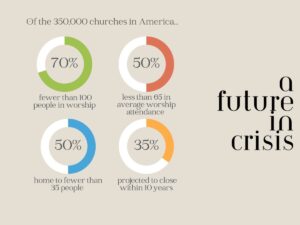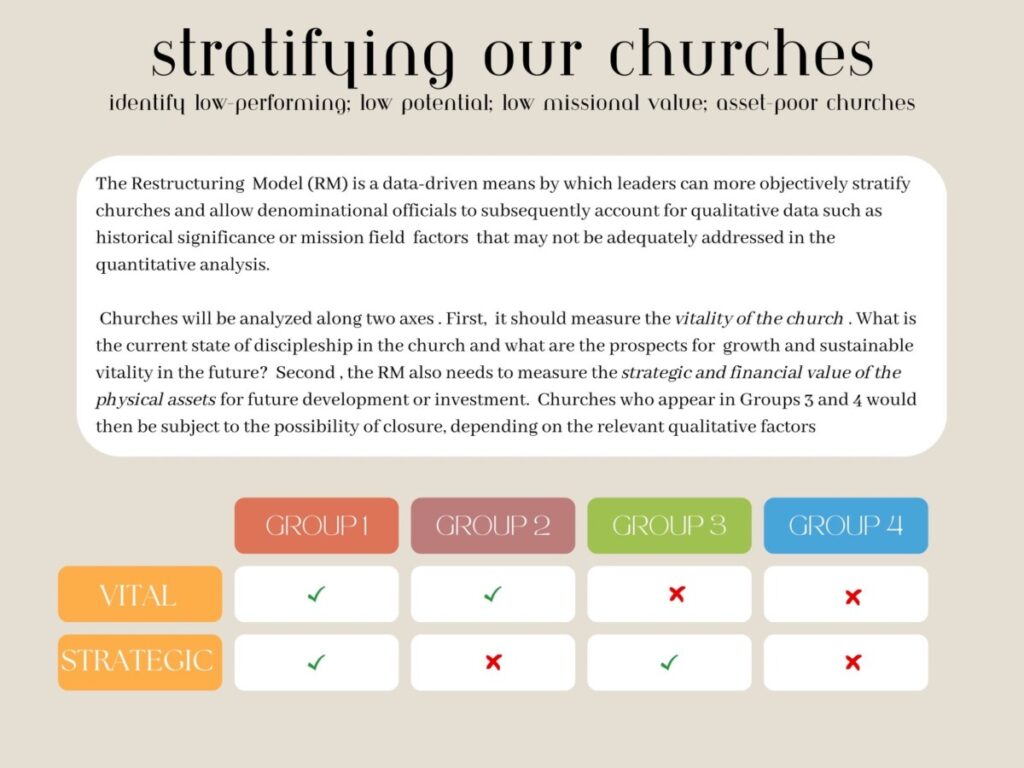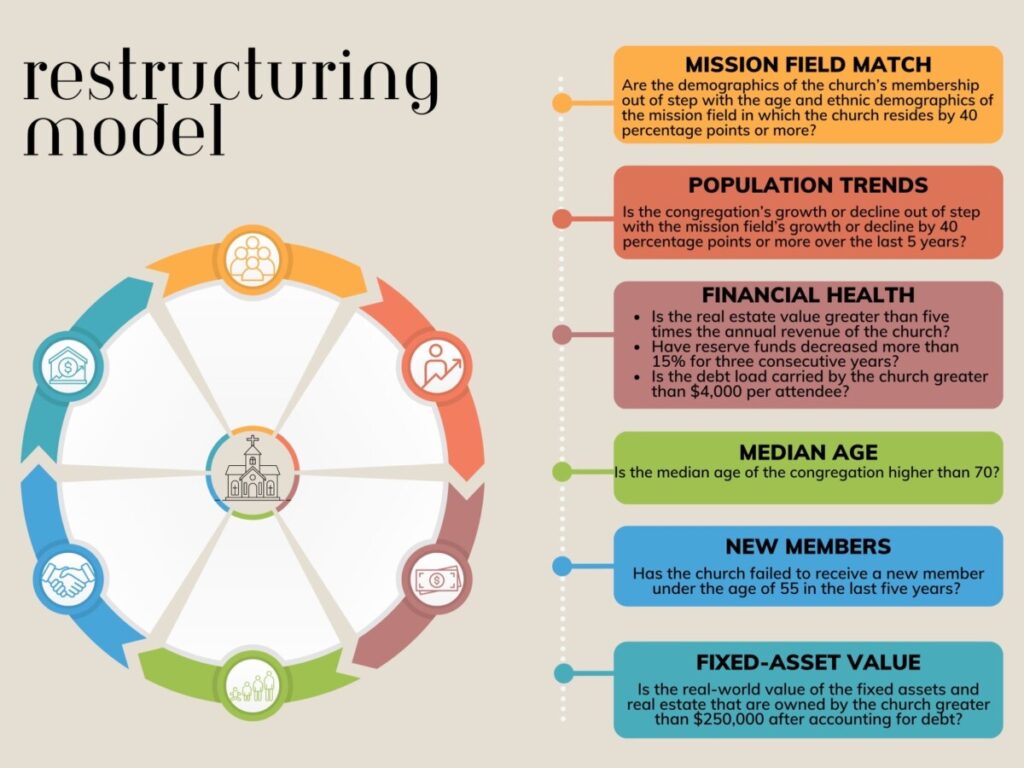Facing an Existential Ecclesial Crisis
The United Methodist Church in America, alongside virtually every form of historically Wesleyan ecclesial expression, is facing multiple, significant crises. Much has been spoken, written and shouted with regard to these crises: schism (ostensibly over disagreements about human sexuality), a theological crisis of identity (to what degree will our sources of theological authority empower or inhibit theological evolution), the precarious position of our longstanding Methodist polity (connectionalism, the appointive system and the role and function of the episcopacy, to name just a few), the rise of tribalism and political unrest in the United States and around the globe, the blessing and curse of social media and the loss of engagement brought about by the Covid-19 pandemic.[1] Any one of these crises would be enough to threaten the health and longevity of a denomination, but the confluence of these phenomena is creating a staggering effect on a sixth crisis. Too little attention has been paid to the extraordinary financial threat that is charging headlong toward the UMC (in reality, it has already arrived). Although localized concern has been expressed by leaders in various corners of the denomination, the crises listed above have absorbed so much time, energy and emotional space that the economic reality facing churches, particularly in the wake of Covid-19, has not been taken into adequate account.
The decline in attendance and giving associated with an aging denomination, our failure to successfully attract a new and far more diverse population of congregants, a denomination in doctrinal and ecclesiological crisis, and diminished engagement post-pandemic will likely facilitate a tsunami-like wave of church closures within 10 years if church leaders fail to confront these issues and shrink from their duty as stewards of the faith (see chart 1[2]).
Our failure to act now will exacerbate our economic and leadership challenges in a manner that perpetuates unrealized opportunities for the Kingdom of God. It is time, perhaps past time, to consider a more robust solution that could preserve existing resources and extend the metaphorical runway long enough for renewal and rebirth to gain traction. Although this proposal may be painful in the short-term, over time it will prove to be a necessary investment in the long-term success of the UMC. The missional mandate of the Church that is outlined in the Nicene Creed- “one, holy, catholic and apostolic” suggests that the needs of an individual congregation must take a back seat to God’s desire for the Church to carry on the transformative work of the Gospel in new generations.
Time to Prune
If passively allowing churches to wither on the vine (which is the current, default approach) is not strategically viable, then what model or response to these crises would be strategically feasible, biblically rooted, theologically sound and pastorally aware? A strategic reorganization is not only possible, it is required by the circumstances in which the denomination finds itself. Strategic reorganization, in this context, refers to a dramatic downsizing of our brick and mortar assets that would free capital resources in order to invest in the people, technology and innovation that will support future growth and meet our changing society where it is. Specifically, over a reasonable amount of time and in a carefully managed process, the reorganization would significantly reduce the number of United Methodist churches within a given geographic area (i.e. within an Annual Conference) by 25-50%. Although the size of this proposal will generate initial ‘sticker shock,’ there is good reason to believe that anything less will fail to move the needle enough to alter the inevitability of the denomination’s predicament.
Strategy is deciding both what to do and what not to do. To ensure the greatest possible sensitivity to our existing churches and communities, we should not passively wait for our weakest churches to inevitably decline and likely die. Rather, a strategic reorganization would be data-driven, well-planned, well-managed and proactive in identifying which churches must remain open and which churches need to be closed for the sake of the greater good. This would reduce the overwhelming need to fill pulpits, allow middle management to maintain closer contact, with more intimate knowledge of a smaller number of clergy, local churches and mission fields and provide seed-capital for reimagining the church in order to meet modern challenges and opportunities. The endgame is not to lengthen the runway for the decline of the church. Rather, the broader ecclesial goal is to redistribute and reallocate resources in order to invest in more contextual, sustainable and creative ways of being the Church while identifying new and creative ways to reach the unchurched.
How to Prune Well
The means by which a restructuring strategy might be pursued are worthy of the most careful consideration. This kind of strategy has the potential to do untold interpersonal and organizational damage if executed poorly, with uninformed assumptions or without appropriate reflection and preparation. If a leader desired to proactively close churches on a large scale, how could they confidently, compassionately and accurately stratify churches according to which churches ought to be closed, which churches are viable candidates for re-investment and which churches would remain untouched? Such a leader would need a robust, strategic means by which many hundreds of churches could be stratified according to their current state and future potential. Naturally, qualitative data must also be taken into account in this kind of environment; numbers cannot tell the full story or weigh the story of the heart. Nonetheless, quantitative data and analysis can help cut through some of the emotionally laden challenges within a given context and paint a realistic picture about the cost of inaction. The primary audience for this instrument is denominational leaders who have the decision-making authority to implement change. The cohort toward which this instrument of analysis is built consists primarily of churches whose average weekly worship attendance is 100 congregants or less. The likelihood of turnaround diminishes significantly at this size of church, often due to age of membership and the financial capacity the attendees to sustain operations. Thus as a cohort, churches of this size, which represent 69% of the 350,000 US churches,[3]experience the greatest risk of failure.
Leaders need a data-driven Restructuring Model (RM) that can more objectively stratify churches and allow denominational officials to subsequently account for qualitative data such as historical significance or mission field factors that may not be adequately addressed in the quantitative analysis. Such an RM ought to analyze churches along two axes. First, it should measure the vitality of the church. What is the current state of discipleship in the church and what are the prospects for growth and sustainable vitality in the future? Second, the RM also needs to measure the strategic and financial value of the physical assets for future development or investment. This tool will stratify churches into one of four quadrants (see chart 2),
and the purpose of this stratification is to identify low-performing, low potential, low missional value, asset-poor churches.
There is a virtually unlimited number of measurements that leaders could conceivably factor into their stratification criteria related to church vitality. However, for the sake of keeping the instrument simple enough to be deployed effectively and with relative ease, there are only six quantitative factors and one qualitative element included in the RM’s analysis of a church’s vitality and strategic value. To add to the ease of use, the analysis of each of the six quantitative factors can be largely accomplished with data that United Methodist churches are required to report each year (of course, this will vary across denominations, depending on denominational reporting practices). The criteria, or measures, listed below are not listed in a prioritized order (see chart 3).
The RM is built on a scoring methodology that will clarify each church’s level of risk accordingly. After answers to these six quantitative measures are collected, churches will be scored such that leaders will be able to group churches into the following categories: critical, at-risk, low risk. When evaluating a given church, a ‘yes’ answer to one of the six quantitative measures is scored as one point. Note that the third measure, which is related to financial health, contains three questions; thus a church could receive three ‘points’ if each of the three questions is answered in the affirmative. The highest possible score is 8. Any church who receives a score greater than 5 is considered critical and merits strong consideration for closure. A church that scores between 3 and 5 ought to be considered at-risk of closure, and a score less than 3 is considered low risk.
Alongside the quantitative data, leaders must allow qualitative data to hold an authoritative position (akin to veto power) in the analytical process. What is the story of the church? It must be remembered throughout this evaluative process that data alone cannot tell the full and complete story of a church’s value or potential.
A Future with Hope
The restructuring strategy of closing churches at a more robust pace is an uphill emotional battle in most quarters. It is a fearful thing for many people to consider closing even a single church because it appears on the surface to signal surrender. However, we have to wonder whether our ecclesiology is really so weak as to be afraid that if we do not have a church on every street corner and in every small town, then the world will forget that we exist? As with the biblical image of pruning, a military metaphor of strategic retreat from the battlefield, or a business metaphor of changing markets and the natural evolution of new products, services and rebirth, there is hope in this strategy as well. It confronts the current crisis rather than ignoring it and pretending that it does not exist. It affords the Church an opportunity to redirect resources toward ministries that could generate ongoing Kingdom returns. It preserves the agency of the leadership so that proactive decisions can be made that will serve the best interest of the Church and its mission. The United Methodist Church has an estimated $50 Billion in real estate assets in the United States. Most of those real estate assets belong to churches that have less than 100 people in worship. Monetizing even a quarter of that number ($12.5 billion) would provide enough cash reserves to reinvigorate Methodism and produce profound results throughout our sphere of influence.
Suggested Reading:
Hoyt, William R. Effectiveness by the Numbers Counting What Counts in the Church. Nashville, Tenn: Abingdon Press, 2007.
Reinhard, Rick. “A Call to Examine United Methodist Real Estate.” United Methodist News, (September 15, 2021): https://www.umnews.org/en/news/a-call-to-examine-united-methodist-real-estate
Thumma, Scott. 2021. “Exploring the Dynamics and Challenges of Congregational Size.” Theology Today 78 (3): 285–96.
Endnotes
[1] Thumma’s work demonstrates an increasing and dramatic trend in membership distribution that heavily favors large churches to the detriment of small churches, which are the major focus of this paper. Importantly, Thumma notes that the “full impact of the pandemic…will likely exacerbate this trend.” Thumma, Scott. 2021. “Exploring the Dynamics and Challenges of Congregational Size.” Theology Today 78 (3): 285–96.
[2] Rick Reinhard, “A Call to Examine United Methodist Real Estate.” United Methodist News, (September 15, 2021): https://www.umnews.org/en/news/a-call-to-examine-united-methodist-real-estate
[3] Thumma, 286.



